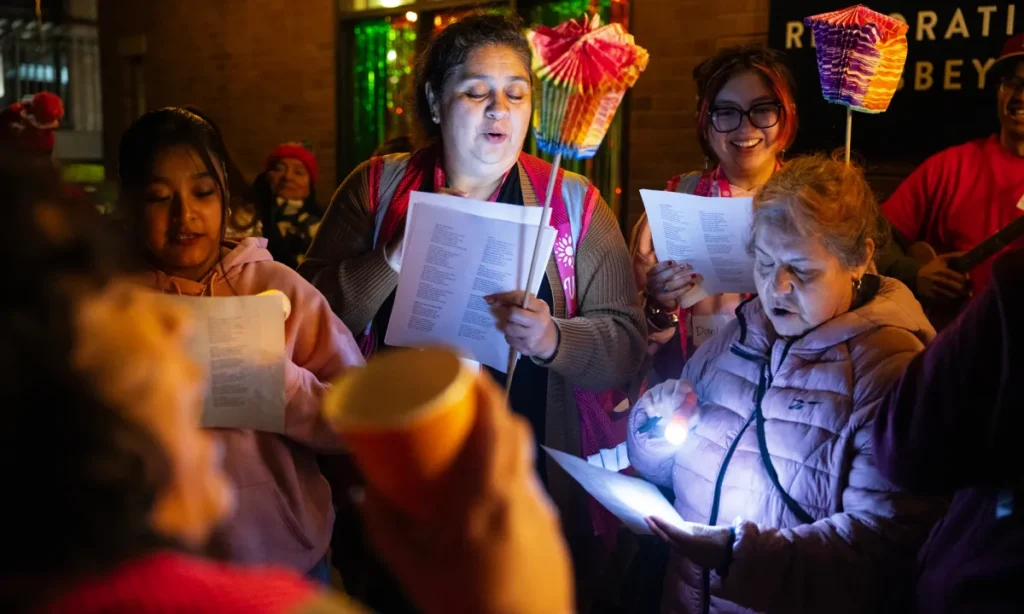Share
WASHINGTON — President Donald Trump is painting a false picture of a U.S. economy unaffected by his trade war with China and other countries.
He describes a blue-sky world in which rapidly escalating tariffs have no impact on American consumers even as a raft of businesses and economists say otherwise, chastising those who caution of potential weakness in the economy as partisans.
“Our Country, economically, is doing great – the talk of the world!” he tweeted Sunday.
He’s glossing over the facts.
Some economists have put the costs to an average U.S. household from Trump’s pending tariffs on imports from China at $1,000 per year or more, not taking into account the most recent tax hike the president announced Friday of up to 30% on goods. Trump also insisted that economists don’t believe his trade disputes with China could spur recession, but in fact most analysts believe a downturn could start in the next two years.
The claims capped a week in which Trump repeatedly misrepresented his administration’s record, also citing false progress on veterans’ health care, boasting misleadingly about his judicial nominations and blaming President Barack Obama for a policy of separating migrant families that he himself started.
A look at the claims:
Economy
TRUMP: “I think our tariffs are very good for us. We’re taking in tens of billions of dollars. China is paying for it.” — remarks Friday night to reporters before leaving for the Group of Seven summit in France.
TRUMP: “It’s coming in by the billions. We never got 10 cents from China.” — remarks Sunday with the British prime minister at G-7 summit.
TRUMP: “The tariffs have cost nothing, in my opinion. …And we’re not paying for the tariffs; China is paying for the tariffs, for the one-hundredth time.” — remarks on Aug. 18 to reporters in Morristown, New Jersey.
THE FACTS: Americans, in fact, are paying for the tariffs. It’s also false to say the U.S. never collected a dime in tariffs on Chinese goods before Trump took action; they are simply higher in some cases than they were before.
In a study in May, the Federal Reserve Bank of New York, with Princeton and Columbia universities, estimated that tariffs from Trump’s trade dispute with China were costing $831 per U.S. household on an annual basis, before tariffs were recently escalated. Analysts also found that the burden of Trump’s tariffs falls entirely on U.S. consumers and businesses that buy imported products.
A report this month by JPMorgan Chase estimated that tariffs would cost the average American household $1,000 per year if tariffs on another $300 billion of U.S. imports from China proceed in September and December. Trump has since bumped up the scheduled levies even higher, likely adding to the U.S. burden. He announced Friday that tariffs on the $300 billion in goods would increase from 10% to 15%; existing tariffs on another $250 billion in Chinese imports would go from 25% to 30% on Oct. 1 after public feedback.
Trump also has threatened anew to place tariffs on French wine imports to the U.S. in a spat over France’s digital services tax; the European Union promised to retaliate. On Sunday, after saying he had “second thoughts” about the trade war with China, the White House later made clear his only regret was that he didn’t raise tariffs higher.
The Congressional Budget Office said last week that “trade policies” were weighing on U.S. economic activity, particularly business investment.
“Businesses’ uncertainty about trade policies is expected to continue to weigh on private investment and, thus, output,” it said.
___
TRUMP, asked if he should take responsibility for a 600-point drop Friday in the Dow Jones industrial average spurred by his escalating trade war: “Not at all. Because if you look at from November 9th — the day after the election — we’re up 50% or more. We’re up many, many points. We were at about sixteen or seventeen thousand. We’re at 25,000.” — remarks Friday night to reporters.
TRUMP, on the news media: “They are trying to force a Recession, they are trying to ‘will’ America into … bad Economic times.” — tweets Sunday.
THE FACTS: He’s inflating the stock market performance since he was elected.
The Dow closed at 18,590 on Nov. 9, 2016, the day after Trump’s election, and it closed at 25,627 last Friday — a 38% increase.
While Trump now regularly praises a rising stock market and blasts those who try to promote “bad economic times,” he wasn’t always such a big cheerleader.
During the 2016 campaign, Trump derided the economic recovery under Obama as a mirage, dismissing stock gains and warning of recession. “The only thing that looks good is the stock market, but if you raise interest rates even a little bit, that’s going to come crashing down,” Trump said in Sept. 2016. “We are in a big, fat, ugly bubble.”
___
TRUMP: “I don’t think we’re having a recession. We’re doing tremendously well … And most economists actually say that we’re not going to have a recession.” — remarks to reporters in Morristown, New Jersey.
THE FACTS: Actually, most economists — about 74% — do expect a recession in the U.S. by the end of 2021.
The economists surveyed by the National Association for Business Economics mostly didn’t share Trump’s optimistic outlook for the economy. Thirty-four percent of the economists said they believe a slowing economy will tip into recession in 2021. That’s compares with 25% in the February survey.
An additional 38% of those polled predicted that recession will occur next year, down slightly from 42% in February. An additional 2% of those polled expect a recession to begin this year.
The 226 economists responding work mainly for corporations and trade associations.
The economists have previously expressed concern that Trump’s tariffs and higher budget deficits could eventually slow the economy.
The Trump administration has imposed tariffs on goods from many key U.S. trading partners, from China and Europe to Mexico and Canada. On Friday, Trump escalated his trade fight with China by raising retaliatory tariffs and ordering American companies to consider alternatives to doing business there, maintaining that the tariffs will help the administration gain more favorable terms of trade. But U.S. trading partners have also retaliated with tariffs of their own.

TRUMP: “Germany sells 30 year bonds offering negative yields. Germany competes with the USA. Our Federal Reserve does not allow us to do what we must do. They put us at a disadvantage against our competition.” — tweet Thursday.
THE FACTS: Trump misrepresents the impact of Federal Reserve policies and is mistaken about Germany’s economy, suggesting that it enjoys some kind of advantage. In fact, the negative yields are a sign of that economy’s weakness.
The German economy shrank in the previous quarter and there are expectations from investment banks that Germany soon could fall into a recession. Nor is the phenomenon isolated to Germany. Japan and much of Europe are also struggling with interest rates on government debt that are negative or close to negative.
Investors are betting that stimulus efforts by the European Central Bank will keep rates persistently low. But the negative interest rates on German bonds also reflect that government’s aversion to issuing debt, even though the borrowing would allow it to spend more on roads and bridges to spur stronger economic growth.
By having even slightly positive interest rates compared to the rest of the world, the United States is in a better position to attract global investment.
Migrants
TRUMP: “President Obama had separation. I’m the one that brought them together. This new rule will do even more to bring them together. But it was President Obama that had the separation.” — remarks Wednesday to reporters.
Zero tolerance meant that U.S. authorities would criminally prosecute all adults caught crossing into the U.S. illegally. Doing so meant detention for adults and the removal of their children while their parents were in custody. During the Obama administration, such family separations were the exception. They became the practice under Trump’s policy, which he suspended a year ago.
His administration is now moving to end an agreement limiting how long migrant children can be kept in detention. The new rules being adopted by the Homeland Security Department seek to keep families together by holding children in detention longer than the generally held limit of 20 days set by a federal court settlement.
Before Trump’s zero-tolerance policy, migrant families caught illegally entering the U.S. were usually referred for civil deportation proceedings, not requiring separation, unless they were known to have a criminal record. Then and now, immigration officials may take a child from a parent in certain cases, such as serious criminal charges against a parent, concerns over the health and welfare of a child or medical concerns.
Gun Violence
TRUMP, on prospects for gun control after mass shootings in Texas and Ohio: “We have very, very strong background checks right now. … And we’re looking at different things. And I have to tell you that it is a mental problem. And I’ve said it a hundred times: It’s not the gun that pulls the trigger; it’s the person that pulls the trigger.” — remarks Tuesday with Romania’s president.
TRUMP: “I don’t want people to forget that this is a mental health problem. … Just remember this: Big mental problem, and we do have a lot of background checks right now.” — remarks Sunday to reporters in Morristown, New Jersey.
Most people with mental illness are not violent and they are far more likely to be victims of violent crime than perpetrators, according to mental health experts. They say that access to firearms actually is a big part of the problem.
Arthur Evans, chief executive officer of the American Psychological Association, said that red flag laws urged by Trump, which are also known as extreme risk protection orders, are a worthwhile step. Seventeen states and the District of Columbia have such laws, according to the nonprofit Giffords Law Center to Prevent Gun Violence; some have used the laws to temporarily disarm people who have threatened violence.
But Evans and others said assigning too much blame to those with mental illness adds to stigma that keeps people from getting treatment.
A country’s rate of gun ownership is a far better predictor of public mass shootings than indicators of mental illness, said Adam Lankford, a University of Alabama criminologist who published a 2016 analysis of data from 171 countries.
“The key of what’s going on here is access to guns for people who are dangerous or disturbed,” Lankford said. Red flag laws make it easier to disarm people believed to be a danger to themselves or others, “but sometimes there are not clear warning signs or those signs are not reported to the authorities until after an attack,” he said.
Last month, the U.S. Secret Service released a report on mass public attacks in 2018, finding that “no single profile” can be used “to predict who will engage in targeted violence” and “mental illness, alone, is not a risk factor.”

Autos
TRUMP: “The Legendary Henry Ford and Alfred P. Sloan, the Founders of Ford Motor Company and General Motors, are ‘rolling over’ at the weakness of current car company executives.” — tweet Wednesday.
THE FACTS: He’s incorrect that Sloan is the founder of General Motors.
William Durant started GM in 1908, combining several companies that produced Buick, Oldsmobile, Cadillac and other vehicles. Sloan was a longtime president, CEO and chairman of GM, leading the company from the 1920s to the 1950s.
___
TRUMP: “My proposal to the politically correct Automobile Companies would lower the average price of a car to consumers by more than $3000, while at the same time making the cars substantially safer. Engines would run smoother. Very little impact on the environment! Foolish executives!” — tweet Wednesday.
THE FACTS: Trump is inflating the projected savings to consumers under his plan to freeze Obama-era fuel economy requirements at 2021 levels. He’s also minimizing the potential environmental harm.
His administration, in documents proposing to freeze the standards, puts the cost of meeting the Obama-era requirements at around $2,700 per vehicle. It claims buyers would save that much by 2025, over standards in place in 2016. But that number is disputed by environmental groups and is more than double the estimates from the Obama administration.
Trump’s tweet also is ignoring money that consumers would save at the gas pump if cars get better mileage. A study released Aug. 7 by Consumer Reports found that the owner of a 2026 vehicle will pay over $3,300 more for gasoline during the life of a vehicle if the standards are frozen at 2021 levels. The administration’s proposed freeze would hold the average fuel economy for the new-vehicle fleet at 29.1 mpg in real-world driving, while the Obama-era standards would raise it to 37.5 mpg by 2026, according to Consumer Reports.
Trump claims his proposal would cause little environmental harm, but documents from his administration say that U.S. fuel consumption would increase by about 500,000 barrels per day, a 2% to 3% increase. Environmental groups predict even more fuel consumed, resulting in higher pollution.
Trump’s statement that cars would be substantially safer also is in dispute. His administration argues that lower-cost vehicles would allow more people to buy new ones that are safer, cutting roadway deaths by 12,700 lives through the 2029 model year. But Consumer Reports says any safety impact from changes in gas mileage standards are small and won’t vary much from zero.
And there’s little basis for Trump’s claim that engines would run more smoothly. Early versions of cars with more fuel-efficient transmissions, turbochargers and technology that stops engines at red lights were rough, but those have been refined. “The automakers have figured out how to use this technology and make the cars smoother driving, too,” said Jake Fisher, Consumer Reports director of auto testing.
Veterans
TRUMP: “My administration has worked aggressively to boost veterans employment, and we’re setting records. … Veterans unemployment has reached the lowest level ever recorded.” — remarks Wednesday at AMVETS convention in Louisville, Kentucky.
THE FACTS: It’s true that the unemployment rate for veterans fell to 2.3% in April, matching the low set in May 2000 under President Bill Clinton. But this figure is volatile on a monthly basis, not adjusted for seasonal changes, and has since risen. The figure stood at 3.4% in July, according to the Labor Department.
Veterans’ unemployment has fallen mostly for the same reasons that joblessness has dropped generally: strong hiring and steady economic growth over the past decade dating to the Obama administration.
___
TRUMP: “The VA is now providing same-day emergency mental health care and mental health screenings to every patient that walks through the door.” — AMVETS convention.
THE FACTS: Same-day mental health service started at VA before Trump took office in January 2017.
VA’s effort to provide same-day primary and mental-health care when medically necessary at every VA medical center was publicized in April 2016, during the Obama administration. By late 2016, the department’s blog announced that goal would be achieved by year’s end.
A Dec. 23, 2016, article in the Harvard Business Review cites new same-day services at all VA hospitals as evidence of notable progress at the department. Former VA Secretary David Shulkin told Congress in late January 2017 the services already were fully in place.
___
TRUMP: “Veterans Choice, as you’ve been trying to get that for 44 years, they say — 44 years. I guess it’s longer than that; probably earlier than that. But for 44 years, at least, that we know of. And you got it.” — AMVETS convention.
THE FACTS: You wouldn’t know from Trump’s boasting that it was Obama who won passage of the Veterans Choice program, which gives veterans the option to see private doctors outside the VA medical system at government expense. Congress approved the program in 2014, and Obama signed it into law. Trump expanded it. Its ultimate scope remains uncertain, in part because of questions of money.
Judges
TRUMP: “We will have, within another 90 days, 179 federal judges. And I say, ‘Thank you very much, President Obama.’ Because he was unable to get them filled. I don’t know what happened to him, but he was unable. So, President Obama did not do his job.” — remarks on Aug. 18 to reporters in Morristown, New Jersey.
THE FACTS: Trump does have a stronger record than Obama so far in picking federal judges, but it isn’t due to complacency from the Obama administration. Instead, unprecedented lack of action by the Republican-controlled Senate on Obama’s judicial nominees in his last two years in office left Trump more vacancies to fill.
Of the 71 people whom Obama nominated to the district courts and courts of appeals in 2015 and 2016, only 20 were voted on and confirmed, said Russell Wheeler, an expert on judicial nominees at the Brookings Institution. Trump entered office in January 2017 with more than 100 vacancies on the federal bench, about double the number Obama had in 2009. Trump has since been aided by Senate Majority Leader Mitch McConnell, R-Ky., who has pushed through Trump’s nominations of appeals court judges in particular.
Wheeler said Trump has had 146 judges confirmed and seated — a pace that is solid but not extraordinary . At least four other presidents — Clinton, John Kennedy and Richard Nixon in modern times as well as George Washington — surpassed him at comparable points in their terms in the number of appointees as a percentage of “authorized judgeships,” or the total judicial seats created by Congress.
Wheeler doesn’t put much stock in Trump’s claim of reaching 179 federal judges within two months. Twenty-five nominees have had their Senate hearings and may be ready to be voted on soon, but that doesn’t mean it will happen. “It’s a moving target,” he said.
Categories

Pebble Is a Tiny Adventure Seeker With a Big Heart


















